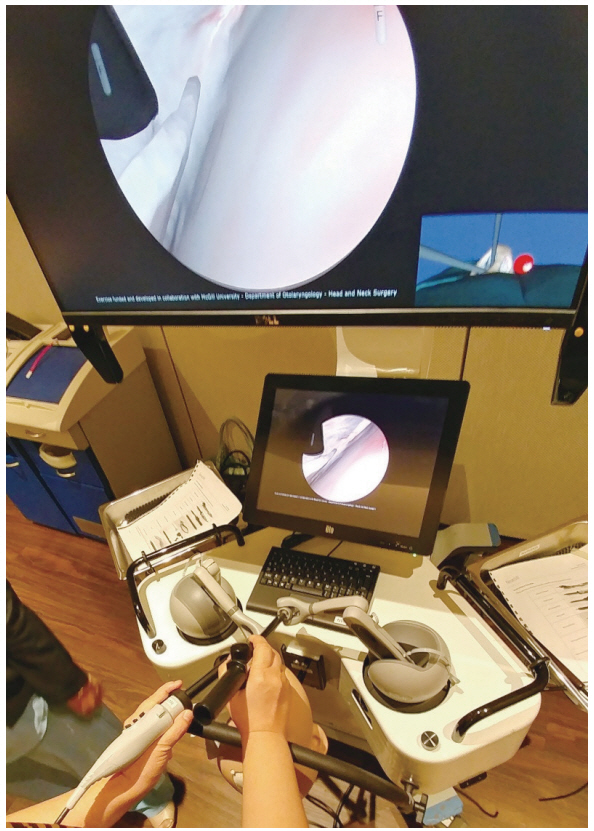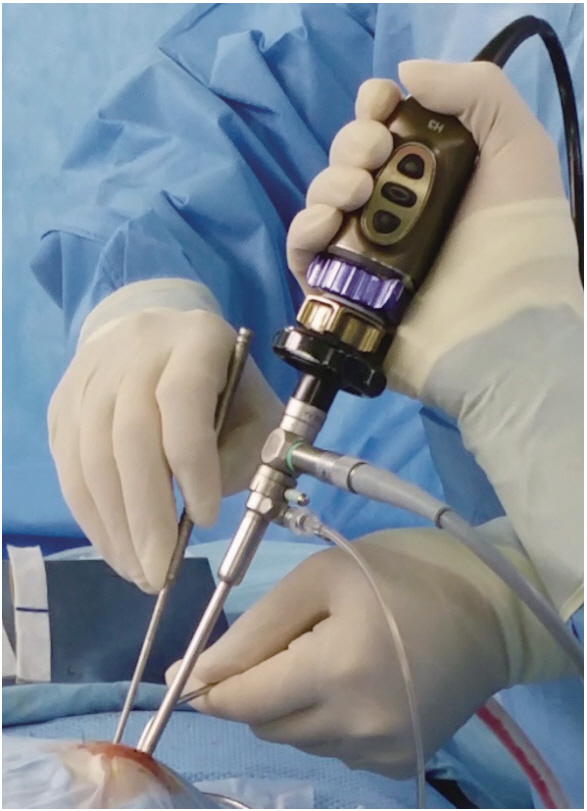Clin Exp Otorhinolaryngol.
2019 Feb;12(1):12-17. 10.21053/ceo.2018.00906.
Virtual Reality Simulators for Endoscopic Sinus and Skull Base Surgery: The Present and Future
- Affiliations
-
- 1Department of Otolaryngology-Head and Neck Surgery, Seoul St. Mary's Hospital, College of Medicine, The Catholic University of Korea, Seoul, Korea. kswent@catholic.ac.kr
- 2Department of Neurosurgery, Seoul St. Mary's Hospital, College of Medicine, The Catholic University of Korea, Seoul, Korea.
- KMID: 2437486
- DOI: http://doi.org/10.21053/ceo.2018.00906
Abstract
- Endoscopic sinus and skull base surgeries are minimally invasive surgical techniques that reduce postoperative symptoms and complications and enhance patients' quality of life. However, to ensure excellent surgical outcomes after such interventions, intimate familiarity with important landmarks and high-level endoscope manipulation skills are essential. Cadaver training is one possible option, but cadavers are expensive, scarce, and nonreusable and cadaver work requires specialized equipment and staff. In addition, it is difficult to mimic specific diseases using cadavers. Virtual reality simulators can create a computerized environment in which the patient's anatomy is reproduced and interaction with endoscopic handling and realistic haptic feedback is possible. Moreover, they can be used to present scenarios that improve trainees' skills and confidence. Therefore, virtual simulator training can be implemented at all levels of surgical education. This review introduces the current literature on virtual reality training for endoscopic sinus and skull base surgeons, and discusses the direction of future developments.
Keyword
MeSH Terms
Figure
Cited by 2 articles
-
Understanding the Biomechanical Properties of Skull Base Tissues Is Essential for the Future of Virtual Reality Endoscopic Sinus and Skull Base Surgery Simulators
Valentin Favier, Patrice Gallet, Gérard Subsol, Guillaume Captier
Clin Exp Otorhinolaryngol. 2019;12(2):231-232. doi: 10.21053/ceo.2018.01627.Recent Advances in the Application of Artificial Intelligence in Otorhinolaryngology-Head and Neck Surgery
Bayu Adhi Tama, Do Hyun Kim, Gyuwon Kim, Soo Whan Kim, Seungchul Lee
Clin Exp Otorhinolaryngol. 2020;13(4):326-339. doi: 10.21053/ceo.2020.00654.
Reference
-
1. Rotenberg B, Tam S, Ryu WH, Duggal N. Microscopic versus endoscopic pituitary surgery: a systematic review. Laryngoscope. 2010; Jul. 120(7):1292–7.
Article2. Strychowsky J, Nayan S, Reddy K, Farrokhyar F, Sommer D. Purely endoscopic transsphenoidal surgery versus traditional microsurgery for resection of pituitary adenomas: systematic review. J Otolaryngol Head Neck Surg. 2011; Apr. 40(2):175–85.3. De Nicola M, Salvolini L, Salvolini U. Virtual endoscopy of nasal cavity and paranasal sinuses. Eur J Radiol. 1997; May. 24(3):175–80.
Article4. Edmond CV Jr, Heskamp D, Sluis D, Stredney D, Sessanna D, Wiet G, et al. ENT endoscopic surgical training simulator. Stud Health Technol Inform. 1997; 39:518–28.5. Rudman DT, Stredney D, Sessanna D, Yagel R, Crawfis R, Heskamp D, et al. Functional endoscopic sinus surgery training simulator. Laryngoscope. 1998; Nov. 108(11 Pt 1):1643–7.
Article6. Arora H, Uribe J, Ralph W, Zeltsan M, Cuellar H, Gallagher A, et al. Assessment of construct validity of the endoscopic sinus surgery simulator. Arch Otolaryngol Head Neck Surg. 2005; Mar. 131(3):217–21.
Article7. Edmond CV Jr. Impact of the endoscopic sinus surgical simulator on operating room performance. Laryngoscope. 2002; Jul. 112(7 Pt 1):1148–58.
Article8. Edmond CV Jr, Wiet GJ, Bolger B. Virtual environments: surgical simulation in otolaryngology. Otolaryngol Clin North Am. 1998; Apr. 31(2):369–81.9. Fried MP, Sadoughi B, Gibber MJ, Jacobs JB, Lebowitz RA, Ross DA, et al. From virtual reality to the operating room: the endoscopic sinus surgery simulator experiment. Otolaryngol Head Neck Surg. 2010; Feb. 142(2):202–7.
Article10. Fried MP, Sadoughi B, Weghorst SJ, Zeltsan M, Cuellar H, Uribe JI, et al. Construct validity of the endoscopic sinus surgery simulator. II. Assessment of discriminant validity and expert benchmarking. Arch Otolaryngol Head Neck Surg. 2007; Apr. 133(4):350–7.11. Fried MP, Satava R, Weghorst S, Gallagher AG, Sasaki C, Ross D, et al. Identifying and reducing errors with surgical simulation. Qual Saf Health Care. 2004; Oct. 13 Suppl 1:i19–26.
Article12. Kassam AB, Prevedello DM, Carrau RL, Snyderman CH, Thomas A, Gardner P, et al. Endoscopic endonasal skull base surgery: analysis of complications in the authors’ initial 800 patients. J Neurosurg. 2011; Jun. 114(6):1544–68.
Article13. Solyar A, Cuellar H, Sadoughi B, Olson TR, Fried MP. Endoscopic Sinus Surgery Simulator as a teaching tool for anatomy education. Am J Surg. 2008; Jul. 196(1):120–4.
Article14. Uribe JI, Ralph WM Jr, Glaser AY, Fried MP. Learning curves, acquisition, and retention of skills trained with the endoscopic sinus surgery simulator. Am J Rhinol. 2004; Mar-Apr. 18(2):87–92.15. Weghorst S, Airola C, Oppenheimer P, Edmond CV, Patience T, Heskamp D, et al. Validation of the Madigan ESS simulator. Stud Health Technol Inform. 1998; 50:399–405.16. Bockholt U, Muller W, Voss G, Ecke U, Klimek L. Real-time simulation of tissue deformation for the nasal endoscopy simulator (NES). Comput Aided Surg. 1999; 4(5):281–5.
Article17. Ecke U, Klimek L, Muller W, Ziegler R, Mann W. Virtual reality: preparation and execution of sinus surgery. Comput Aided Surg. 1998; 3(1):45–50.
Article18. Caversaccio M, Eichenberger A, Hausler R. Virtual simulator as a training tool for endonasal surgery. Am J Rhinol. 2003; Sep-Oct. 17(5):283–90.
Article19. Kockro RA, Stadie A, Schwandt E, Reisch R, Charalampaki C, Ng I, et al. A collaborative virtual reality environment for neurosurgical planning and training. Neurosurgery. 2007; Nov. 61(5 Suppl 2):379–91.
Article20. Neubauer A, Wolfsberger S, Forster MT, Mroz L, Wegenkittl R, Buhler K. Advanced virtual endoscopic pituitary surgery. IEEE Trans Vis Comput Graph. 2005; Sep-Oct. 11(5):497–507.
Article21. Wolfsberger S, Forster MT, Donat M, Neubauer A, Buhler K, Wegenkittl R, et al. Virtual endoscopy is a useful device for training and preoperative planning of transsphenoidal endoscopic pituitary surgery. Minim Invasive Neurosurg. 2004; Aug. 47(4):214–20.
Article22. Wolfsberger S, Neubauer A, Buhler K, Wegenkittl R, Czech T, Gentzsch S, et al. Advanced virtual endoscopy for endoscopic transsphenoidal pituitary surgery. Neurosurgery. 2006; Nov. 59(5):1001–9.23. Schulze F, Buhler K, Neubauer A, Kanitsar A, Holton L, Wolfsberger S. Intra-operative virtual endoscopy for image guided endonasal transsphenoidal pituitary surgery. Int J Comput Assist Radiol Surg. 2010; Mar. 5(2):143–54.
Article24. Parikh SS, Chan S, Agrawal SK, Hwang PH, Salisbury CM, Rafii BY, et al. Integration of patient-specific paranasal sinus computed tomographic data into a virtual surgical environment. Am J Rhinol Allergy. 2009; Jul-Aug. 23(4):442–7.
Article25. Won TB, Hwang P, Lim JH, Cho SW, Paek SH, Losorelli S, et al. Early experience with a patient-specific virtual surgical simulation for rehearsal of endoscopic skull-base surgery. Int Forum Allergy Rhinol. 2018; Jan. 8(1):54–63.
Article26. Tolsdorff B, Pommert A, Hohne KH, Petersik A, Pflesser B, Tiede U, et al. Virtual reality: a new paranasal sinus surgery simulator. Laryngoscope. 2010; Feb. 120(2):420–6.
Article27. Zirkle M, Roberson DW, Leuwer R, Dubrowski A. Using a virtual reality temporal bone simulator to assess otolaryngology trainees. Laryngoscope. 2007; Feb. 117(2):258–63.
Article28. Dharmawardana N, Ruthenbeck G, Woods C, Elmiyeh B, Diment L, Ooi EH, et al. Validation of virtual-reality-based simulations for endoscopic sinus surgery. Clin Otolaryngol. 2015; Dec. 40(6):569–79.
Article29. Diment LE, Ruthenbeck GS, Dharmawardana N, Carney AS, Woods CM, Ooi EH, et al. Comparing surgical experience with performance on a sinus surgery simulator. ANZ J Surg. 2016; Dec. 86(12):990–5.
Article30. Ruthenbeck GS, Hobson J, Carney AS, Sloan S, Sacks R, Reynolds KJ. Toward photorealism in endoscopic sinus surgery simulation. Am J Rhinol Allergy. 2013; Mar-Apr. 27(2):138–43.
Article31. Guetat A, Ancel A, Marchesin S, Dischler JM. Pre-integrated volume rendering with non-linear gradient interpolation. IEEE Trans Vis Comput Graph. 2010; Nov-Dec. 16(6):1487–94.
Article32. Choudhury N, Gelinas-Phaneuf N, Delorme S, Del Maestro R. Fundamentals of neurosurgery: virtual reality tasks for training and evaluation of technical skills. World Neurosurg. 2013; Nov. 80(5):e9–19.
Article33. Rosseau G, Bailes J, del Maestro R, Cabral A, Choudhury N, Comas O, et al. The development of a virtual simulator for training neurosurgeons to perform and perfect endoscopic endonasal transsphenoidal surgery. Neurosurgery. 2013; Oct. 73 Suppl 1:85–93.
Article34. Varshney R, Frenkiel S, Nguyen LH, Young M, Del Maestro R, Zeitouni A, et al. Development of the McGill simulator for endoscopic sinus surgery: a new high-fidelity virtual reality simulator for endoscopic sinus surgery. Am J Rhinol Allergy. 2014; Jul-Aug. 28(4):330–4.
Article35. Varshney R, Frenkiel S, Nguyen LH, Young M, Del Maestro R, Zeitouni A, et al. The McGill simulator for endoscopic sinus surgery (MSESS): a validation study. J Otolaryngol Head Neck Surg. 2014; Oct. 43:40.
Article36. Castelnuovo P, Pistochini A, Locatelli D. Different surgical approaches to the sellar region: focusing on the “two nostrils four hands technique”. Rhinology. 2006; Mar. 44(1):2–7.
- Full Text Links
- Actions
-
Cited
- CITED
-
- Close
- Share
- Similar articles
-
- Understanding the Biomechanical Properties of Skull Base Tissues Is Essential for the Future of Virtual Reality Endoscopic Sinus and Skull Base Surgery Simulators
- Iatrogenic Skull Base Defect Accompanied by Brain Injury After Endoscopic Sinus Surgery: A Report of Two Cases
- Virtual Reality Technology Trends in Aeromedical Field
- The applications of endoscopic surgery in department of otorhinolaryngology-head and neck surgery
- A Case of Endoscopic Reconstruction of Skull Base Defect Combined with Meningoencephalocele in the Sphenoid Sinus



